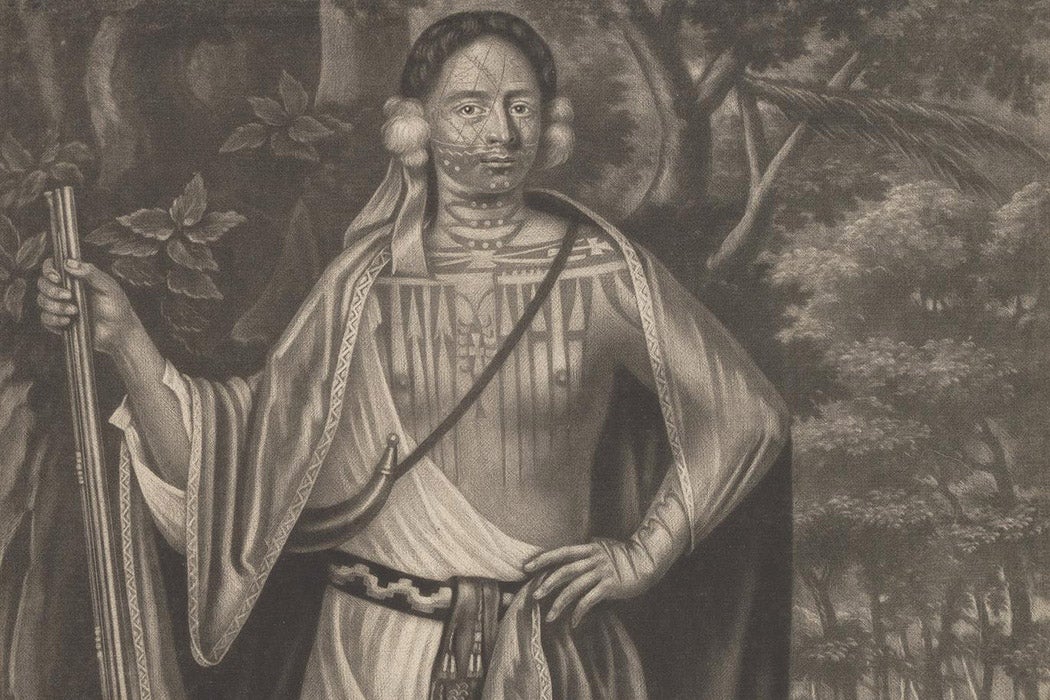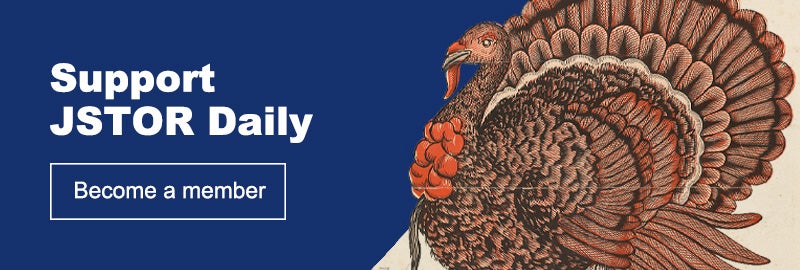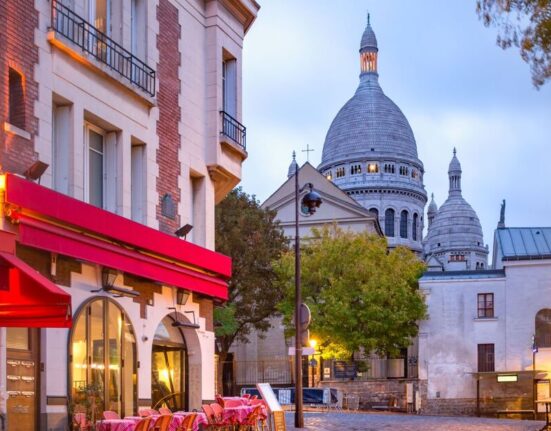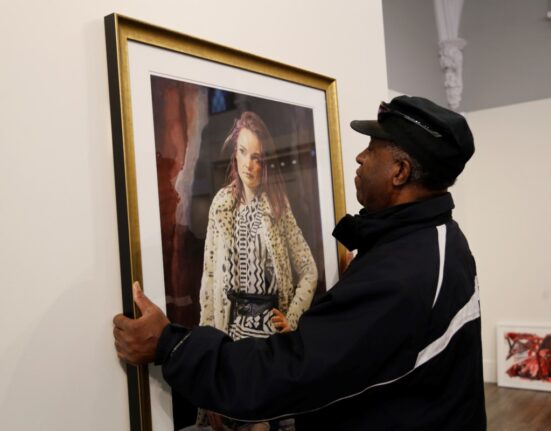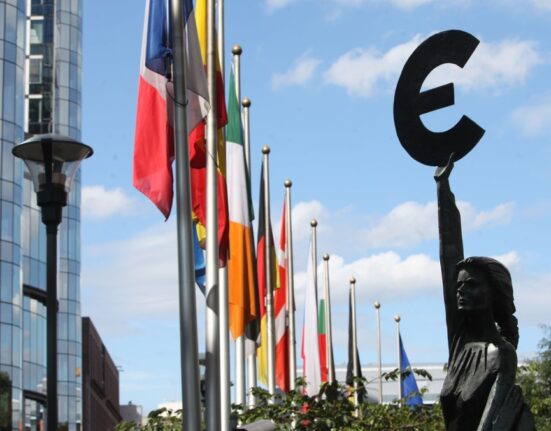The icon indicates free access to the linked research on JSTOR.
Not a feather remains of the Arawak headdress which the seventeenth-century English novelist and playwright Aphra Behn brought back from a trip to tropical Suriname. Neither the turquoise of the tiny cotinga nor the obsidian of the toucan, the jade of the jacamar or the preposterous pink of the flamingo. In the introductory passages to her quasi-autobiographical 1688 novel Oroonoko, the story of a heroic African prince’s rebellion against English slavers in South America, Behn describes how upon returning from Suriname with her headdress she “gave ‘em to the King’s Theatre; it was the dress of the Indian Queen, infinitely admir’d by Persons of Quality; and it was inimitable.” Soon, many believe, the headdress would be featured as a prop in The Indian Queen, a play by John Dryden. “As a material object, the feather marks an act of violence,” writes Joseph Roach in Cities of the Dead: Circum-Atlantic Performance, “what it cost to produce was the original wearer’s life, and what it served to dramatize was the predication of overreaching symbolic systems,” in this case colonialism, as the sacred object was translated into English spectacle, audiences witnessing the bounty of their own imperial ambitions displayed on stage in a brilliant headdress.
As it was, a very different American spectacle would be displayed on an English stage only a few decades on, but the circumstances and implications could scarcely have been more different than from those which attended The Indian Queen. On April 24, 1710, only a month after a successful revival of Dryden’s play, the Queen’s Theatre in Haymarket mounted a production of William Davenant’s operatic version of Shakespeare’s Macbeth. An advertisement posted at the theater’s entrance announced the play was “For the Entertainment of the Four INDIAN KINGS lately arriv’d.”
From the borderlands of what would become the United States and Canada came four Native American representatives to the court of Queen Anne (three of them Haudenosaunee and one Mohican). They were diplomats working to secure an alliance against French ambitions within the interior of North America. Sa Ga Yeath Qua Pieth Tow, known to the English as Peter Brant, a Mohawk and member of the Bear Clan; Ho Nee Yeath Taw No Row, whose Christian name was John of Canajoharie, member of the Wolf Clan; Etow Oh Koam, or Nicholas, adherent of the Thunderbird; and Tee Yee Neen Ho Ga Row who went by King Hendrick, or “Emperor of the Six Nations” in the Haudenosaunee Confederacy (named Iroquois by the French). In London, there had been nothing quite like these men, celebrated for their regal bearing and dignified countenance. Their mission to London was carefully planned and “included appearances at court, at Woolwich Arsenal for a military review, at the Society for the Propagation of the Gospel in Foreign Parts, at a cockfight, at an Italian opera, and at the Board of Trade,” according to Roach. Bearing the most political significance, the leaders exchanged beaded wampum with the Stuart queen as a mark of their alliance.

Technically, none of these men were kings in a European sense—only one had a tenuous connection to the title of Sachem (which roughly translates to “Chief”)—yet in London they carried the authority of dignitaries and, as with the Persian and Moroccan ambassadors earlier that year (the latter taken to Othello), attended a night at the theater. For two centuries there had been accounts of Indigenous Americans in Europe, the Columbian Exchange making the Atlantic Ocean a two-way thoroughfare. The bulk of such interaction rarely benefitted Native Americans, who were often enslaved or exhibited in the equivalent of human zoos or museums. Indeed, such a phenomenon recalls Trinculo enthusiasm in Shakespeare’s The Tempest when he imagines the riches that would come in exhibiting Caliban, “they will lay out ten to see a/dead Indian.” Yet the presence of these four men at another Shakespeare production made a rather different argument, for the Haudenosaunee-Mohican mission to London demonstrated a truism of eighteenth-century international realpolitik—the English needed the Native Americans.
In their jockeying with the French in North America, and their role in what’s known as the War of Spanish Succession, Queen Anne required the assistance of Indigenous allies within the interior of the continent. Eric Hinderaker writes in The William and Mary Quarterly that Queen Anne’s hosting of the mission “posited the existence of native peoples who were capable of serving as effective allies and agents of the crown in the empire-building process,” while Roach counsels readers to remember that “their embassy predated most off the genocidal ruin of North America and that the situation of the English, thinly settled close to the Atlantic seaboard in 1710, was not yet such that they could expect to dictate terms to the Iroquois Confederacy, the influence of which extended across the Great Lakes to the Mississippi Valley.” In other words, the four kings in London are best read in the context of their time, a perspective which grants them their agency, power, and sovereignty.
There was an ideological justification to the choice in entertainment for that night, because Shakespeare’s tale of an honor-bound Medieval Scotland enmeshed in witchery and magic thematically rhymed with English understandings of the Native Americans as primitive, if noble, “natural men.” Audiences that that evening were less interested in Macbeth and his wife than they were in Brant, John, Nicholas, and Hendrick. Outfitted in costumes befitting stage royalty, all black in mourning for Queen Anne’s recently deceased prince consort, the four men in their box seats made a spectacle. “In vain did the players attempt to perform,” writes John Genest in his 1832 history of English theater. “The audience demanded that ‘since we have paid our money, the Kings we will have.’”
To placate the unruly audience, Genest continues, the director “accordingly got four chairs, and placed the Kings on the stage, to the no small satisfaction of the Mob.” There was a degree of the dehumanizing exhibitionism in the “Mob’s” insistence at seeing the kings in this manner, though visiting dignitaries (or other important people) being seated on stage was not uncommon, and satiating understandable curiosity need not be understood as a debasement in and of itself. By contrast, Hinderaker calls the event the “apotheosis of their status as kings in a public setting,” a staging that should not be interpreted as separate from the highly performative honors and responsibilities of European royalty whose own power was often displayed through their comportment, dress, and visibility. If anything, the four men watching Macbeth, somehow both actors and audience, can be read in comparison to Behn’s headdress in The Indian Queen, where the latter is representative of English sovereignty over Native Americans but the former representative of London’s need for Indigenous assistance, a complete upending of the expected power differential.
Behn’s headdress was ephemeral, while the Haudenosaunee-Mohican mission was embedded in the English psyche, in keeping with Westminster’s need for the diplomatic mission to be successful. Indeed, the Haudenosaunee-Mohican presence in Haymarket was long remembered in England, as Genest’s recounting of the night more than a century later demonstrates. Moreover, there are four stunning portraits of the men painted by the Dutch master Jan Verelst displayed at the Libraries and Archive Canada; they had been part of the British Royal Collection until 1977, when the Canadian government acquired them. These full-length paintings are “now known to be among the first painted portraits of Native Americans from the colonial period,” writes Kevin R. Muller in American Art. European aesthetics generally either reduced Native Americans to stereotype or expanded them to symbol. By contrast, Verelst’s compositions draw from the conventions of royal portraiture as combined with natural realism; they depict individuals who are far more than colonial ciphers.
Verelst’s was “an attempt at visual neologism which might meld two representational tropes: portraiture and the depiction of character on the one hand with ‘ethnological’ scrutiny and the depiction of type on the other,” argues Stephanie Pratt in the Oxford Art Journal. In the posing of their bodies, their gestures, and the framing of the figures, the paintings of Brant, John, Nicholas, and Hendrick are clearly in the lineage of portraiture that was applied to monarchs like Queen Anne. In such a radical approach, Verelst’s work arguably foreshadows that of contemporary artists like Telvin Wallace, Tyler Ballon, and of course Kehinde Wiley.
The kings wear both the red velvet and black wool popular then in London, as well as traditional moccasins. They carry weapons, including a bow, a rifle, and a club. They wear wampum beads. Their hair is long, and their faces are adorned with tribal tattoos. Verelst notably places them within what’s presumably the Canadian wilderness; each figure is attended by their totem animal representative of their individual clan—a wolf, a bear, a turtle. Remarkably, these portraits were mass-produced as printed mezzotints, available not just in England, but throughout America where they were known to be displayed in Haudenosaunee longhouses as a mark of the alliance.
“Like the effigy-kings of the theater, these royal guests reigned transiently in the negotiated territory between truth and fiction,” writes Roach, “but their liminal position did not make the interests they represented any less consequential.” Roach’s final point is well-taken, for there is a tendency to teleologically read the history of Indigenous people in the Americas, to assume that the tragedies which befell the Native population were preordained, while in the process denying tribes like the Haudenosaunee Confederacy of their own canny political arrangements and independence. The reality is that in 1710, the English crown needed Native American support, and that even if the four kings were an understandable display upon the streets of London, they were being courted and treated as respected representatives of a sovereign nation. Muller reminds us that “the British did not actually control the Iroquois,” and so in the diplomats’ perambulations in the English capital there is both a potent demonstration of Indian power and an elusive glimpse of an alternative history which did not result in genocide. The description of the kings watching Macbeth, or Verelst’s portraits, greatly complicates the traditional story about colonization, because it reminds us that nothing was inevitable from the eighteenth-century onward. As the Finnish historian Pekka Hämäläinen explains in Indigenous Continent: The Epic Contest for North America the policy of representatives like those from the Haudenosaunee Confederacy “were not the actions of supplicants; the Europeans were the supplicants—their lives, movements, and ambitions determined by Native nations that drew the newcomers into their settlements and kinship networks, seeking trade and allies.”
Even more evocative is the claim of David Graeber and David Wengrow, who argue in The Dawn of Everything: A New History of Humanity that the Enlightenment was directly influenced by the equivalent of Indigenous American philosophers who formulated an ideology of liberty and freedom that was deeply foreign to Europe prior to the eighteenth-century. In particular, they point to the Huron thinker Kondiaronk, who died less than a decade before the Haudenosaunee mission and whose oration was partially recorded by Louis Armand de Lom d’Arce, baron de Lahontan.
“Over and over I have set forth the qualities that we Wyandotte believe ought to define humanity: wisdom, reason, equity,” Kondiaronk declared. A radical assertion in the tremendously hierarchical courts of Europe, but one which would come to define a century of Transatlantic revolutions. If the crowds at Macbeth gawking at these “natural men” understood them as savages, there was also a burgeoning sense that perhaps they were representatives of a civilization that eschewed damaging stratification, arbitrary nobility, and irrational authority.
Telling that a year after the departure of this particular delegation, the Grub Street press was replete with scandalous stories about an anti-elitist sect of Whiggish young men terrorizing the well-heeled nobles of the capital. An anarchic, punkish, rebellious fraternity at the fringes of the nascent Enlightenment. The name this gang supposedly took? “The Mohocks.”
Support JSTOR Daily! Join our membership program on Patreon today.

